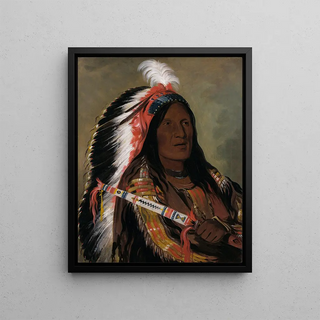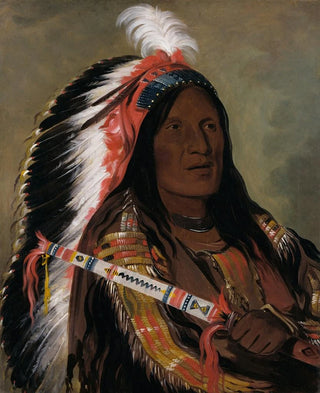Art print | Th-Tck-A-Da-Hir Steep Wind, a brave group of The Bad Arrow Points - George Catlin


View from behind

Frame (optional)
Th-Tck-A-Da-Hir Steep Wind, a brave group by The Bad Arrow Points - George Catlin – Captivating Introduction
At the heart of the 19th century, an era where art intertwines with exploration and discovery, George Catlin, painter and ethnographer, establishes himself as a privileged witness to Native American cultures. His quest to capture the essence of indigenous peoples through his iconic art print, Th-Tck-A-Da-Hir Steep Wind, a brave group by The Bad Arrow Points, immerses us in a universe where nature and humanity meet. This piece, a true ode to the bravery and dignity of tribes, evokes an intense moment of life, a scene where harmony between man and his environment is both celebrated and preserved.
Style and uniqueness of the work
The art print Th-Tck-A-Da-Hir Steep Wind, a brave group by The Bad Arrow Points, stands out for its unique style, blending realism and romanticism. Catlin, with unparalleled mastery, manages to depict not only the physical features of his subjects but also their emotions, struggles, and triumphs. The rich and vibrant color palette evokes the majestic landscapes of the American prairies, while the dynamic composition draws the viewer’s eye, inviting them to immerse themselves in this scene loaded with meaning. Every detail, from traditional costumes to facial expressions, reflects a deep respect for the cultures represented, offering a window into a world in transition, caught between tradition and modernity.
The artist and his influence
George Catlin, beyond being a simple painter, is a true pioneer in documenting Native American cultures. His work is a blend of art and history, an attempt to preserve a heritage threatened by American expansion. Traveling across the United States, he captured the diversity of tribes, their rituals, and daily life, while sparking growing interest in these cultures among European and American audiences. His influence extends far beyond his time, inspiring many artists and ethnologists who, like him, seek to give a voice to marginalized peoples. The richness of his work continues to influence

Matte finish

View from behind

Frame (optional)
Th-Tck-A-Da-Hir Steep Wind, a brave group by The Bad Arrow Points - George Catlin – Captivating Introduction
At the heart of the 19th century, an era where art intertwines with exploration and discovery, George Catlin, painter and ethnographer, establishes himself as a privileged witness to Native American cultures. His quest to capture the essence of indigenous peoples through his iconic art print, Th-Tck-A-Da-Hir Steep Wind, a brave group by The Bad Arrow Points, immerses us in a universe where nature and humanity meet. This piece, a true ode to the bravery and dignity of tribes, evokes an intense moment of life, a scene where harmony between man and his environment is both celebrated and preserved.
Style and uniqueness of the work
The art print Th-Tck-A-Da-Hir Steep Wind, a brave group by The Bad Arrow Points, stands out for its unique style, blending realism and romanticism. Catlin, with unparalleled mastery, manages to depict not only the physical features of his subjects but also their emotions, struggles, and triumphs. The rich and vibrant color palette evokes the majestic landscapes of the American prairies, while the dynamic composition draws the viewer’s eye, inviting them to immerse themselves in this scene loaded with meaning. Every detail, from traditional costumes to facial expressions, reflects a deep respect for the cultures represented, offering a window into a world in transition, caught between tradition and modernity.
The artist and his influence
George Catlin, beyond being a simple painter, is a true pioneer in documenting Native American cultures. His work is a blend of art and history, an attempt to preserve a heritage threatened by American expansion. Traveling across the United States, he captured the diversity of tribes, their rituals, and daily life, while sparking growing interest in these cultures among European and American audiences. His influence extends far beyond his time, inspiring many artists and ethnologists who, like him, seek to give a voice to marginalized peoples. The richness of his work continues to influence






